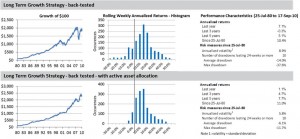Update: The post was included in the The Wealth Builder Carnival
Balancing risk versus return, isn’t that what managing a portfolio really boils down to?
Whether you’re paying someone to actively manage your portfolio or if you’re managing it yourself, what you need to figure out is the amount of risk you can tolerate and then based on your level of risk tolerance, create a portfolio with an optimal mix of asset classes that will maximize returns and minimize risk. This process is called asset allocation and studies have shown that asset allocation explains about 90% of the variability of a (mutual) fund’s returns over time. Think about it, 90% of the variability of a fund’s returns over time. Essentially, what that means is that knowing when to over or underweight asset classes and securities and putting that knowledge into action is principally what you should focus on.
By now you’ve probably guessed that today’s interview is about asset allocation. So without further ado:

Biography: Currently an Investment Counselor & Portfolio Manager at Hottinger Asset Management Canada Inc., Terry Vaughan has over 15 years of experience in portfolio management, equity research and project finance. Before joining Hottinger in July 2010, Terry co-headed the investment team and headed Portfolio Management for UBS’ Wealth Management business in Canada. Prior to UBS, Terry was a Partner at Toron Capital Markets Inc. He is also the past Chair of the Board of Directors for kids.now, a not-for-profit after school program that mentors grade 7 and 8 kids and gives them tools to make the right choices for healthy, satisfying and productive lives. Terry has a degree in Engineering from McMaster University and is a Professional Engineer (Ontario). He also has an MBA from the University of Toronto and holds the Chartered Financial Analyst (CFA) designation.
Q: Terry, can you give us your current thoughts (in terms of current valuations and expectations going forward) on the markets in general and where you see them going from here?
A: Where markets go from here is a tricky question. We have the developed world limping along with the support of incredible amounts of monetary and fiscal stimulus while many developing economies continue to gallop. We continue to have large imbalances in the world – both financial and demographic. Over-consumption in developed economies led to the financial crisis, the effects of which will take some time to work through. And, in the meantime, we’d like to pass the consumption baton to the developing world but they are not yet able to pick up the slack. All of this suggests to us that we are in for a period of slower growth, more modest returns and increased volatility.
Generally speaking, equities appear reasonably / attractively valued but sentiment is shaky due to the issues outlined above. High quality sovereign debt is horrible – yielding nothing or worse net of inflation, yet investors continue to add money. The good news is that while consumers and governments are facing challenges, businesses are generally in good shape. While this offers firms the opportunity to make acquisitions and improve their productivity, they ultimately need confident consumers to grow.
Q: Given your extensive use of ETFs, from the plethora of comparable ETFs available (targeting the same sector, index, commodity etc.), what are some of the things you look at when evaluating which ETF to invest in (e.g. currency, derivative risk, leverage etc.) and can you delve a little bit into why these factors are important?
A: The global growth in ETFs has been incredible – since 1993, we’ve gone from 3 ETFs at <USD 1B globally to 2,379 ETFs at USD 1,181 B (Q3-2010 per BlackRock).
Our expectation of more modest returns and increased volatility is a big reason for our interest in ETFs. The Hottinger Group has guided its clients through 224 years of changing markets. We continue to adapt and innovate. So in addition to our traditional value-oriented and actively managed investment approach, we’ve recently developed simple strategies to participate in market growth but also protect our clients’ assets in down markets. We feel that ETFs are the best way to implement much of this strategy.
So getting back to your question, we use ETFs to attain exposure to various global asset classes in a simple, cost-effective way. We are attracted to the plain vanilla structures (vs. the derivative-based / leveraged / inverse, etc. structures) and seek to minimize foreign currency risk in our portfolios (and therefore use some of the currency-hedged ETFs). Simplicity is important to us – we want our clients to understand what we’re doing with their savings. With the plain vanilla structures, we know what we own and we don’t need to worry about counterparty risk (which is inherent in the swap-based ETFs and ETNs) or the effects of leverage (both positive and negative – including the issue of compounding daily leveraged returns and the unexpected impact this can have on portfolio returns over time).
Q: Can you tell us about your quantitative asset allocation model and what factors/metrics are used by the model? Also is the asset allocation model dependent on the individual client or on the current state of the markets?
A: Sure. we use a simple momentum-based asset allocation model to help us own asset classes when they are performing and hold cash when they are not. The model is based on a simple moving average calculation. In effect, we are managing a slow-moving managed futures-like strategy that aims to be long when markets are good and in cash (vs. short) when markets are bad. We expect the strategies to be long approximately 70% of the time and in cash the remaining 30%.
We offer strategies to suit a range of investment objectives - conservative through aggressive. So the strategy is tailored to the client and the asset allocation model within the strategy is dependent on the state of the markets.
Q: How do you incorporate the information spit out by the asset allocation model into creating an overall strategy? What proportion of your strategy is systematic and what portion discretionary?
A: Essentially, we start with a globally diversified portfolio comprised of approximately 10 to 15 asset classes and use the simple momentum-based asset allocation model to determine how each asset class is trading. If the model is telling us that an asset class is not performing, we sell it and hold cash – otherwise we are long the asset class. The asset allocation component of the strategy is systematic – it is process driven / quantitative in nature. All of this said, there’s nothing to prevent our taking discretionary action in extreme market conditions. (It’s important to note that we are investment counsellors / portfolio managers and manage our client’s portfolios on a discretionary basis in segregated accounts.)
Q: On the topic of aging boomers, we’ve been witnessing a rapid influx of funds into anything with a yield – does the need/want for income, play into your asset allocation model at all?
A: This is a very important issue. As mentioned earlier, we hope the investors that have flooded into bond funds understand what they are doing – we’re afraid they are going to be disappointed and worse, stand to lose money when the economy reflates (never mind what will happen to bonds if governments adopt inflationary policies to help manage their mounting debt loads). We understand that investors want income but we are in a historically low rate environment - unfortunately the 20-odd year bull market in bonds is over. Sure, there are opportunities in investment grade debt, emerging market sovereign debt, high-yield debt and high-yielding stocks but these markets only offer so much and come with their own risks.
Ultimately, the boomers need returns - if these returns come via a security that pays a distribution, that’s great if it makes sense for them but perhaps investors should be thinking more about total return and how to maximize this within their risk tolerance.
The need / want for income is not a big driver of our asset allocation strategies. Our primary goal is to protect our clients’ assets. Our clients worked hard to build their savings and now they are asking us to protect and grow them (to varying degrees depending on their individual circumstances). The boomers can’t tolerate more large drawdowns – they’ve been hit hard twice in the last 10 years – protecting against future drawdowns is key for them.
Q: Capital preservation is crucial to any approach, can you please elaborate in detail how you control risk and volatility?
A: Per above, the momentum-based asset allocation model seeks to control risk (particularly drawdowns) by selling poorly performing asset classes in favour of cash. In a portfolio context, this approach has historically increased returns modestly while reducing annualized volatility and maximum portfolio drawdowns by approximately one third and 70% respectively – this is why we are so excited about the approach.
The following charts highlight the potential we see for the strategy:
The first chart and data set show the return and risk characteristics of our standard long term growth strategy (globally diversified asset allocation – 5% cash, 65% equity, 30% fixed income – most foreign currency hedged back to CAD) – a buy and hold / strategic asset allocation approach. The second chart and data set assumes that we apply our active asset allocation model to the long term growth strategy. As you can see, the active asset allocation model shows the potential to reduce downside volatility without sacrificing return. Per the histograms, the frequency of negative returns (especially large negative returns) is cut dramatically while the frequency of positive returns is not significantly impacted. Average portfolio drawdowns are reduced by more than half and, as mentioned earlier, the maximum drawdown is reduced by 70%. We think the capital protection potential of this approach is very well suited to both the boomers’ needs and the economic / market environment that we find ourselves in.
It’s important to note that the momentum-based tactical asset allocation strategies are new to Hottinger and therefore no actual client performance data is available. These charts and figures are hypothetical / not based on actual client performance and were calculated with the benefit of hindsight. The information has been prepared by back-testing weekly financial market index return data / incorporating the momentum signal and multiplying the resulting returns by fixed strategy allocations. The returns are presented in Canadian Dollar terms. I’d be pleased to provide additional disclosures regarding this hypothetical / back-tested information to anyone that is interested.
Q: Finally, what is your best investment idea (it can be in futures, stocks, ETFs, options or forex) right now? Why do you like it, what are the risks to your investing thesis and do you have any entry/exit points?
A: My best investment idea is to have a plan that suits your needs, that you understand and that you work with someone you trust to execute and review regularly. This is where it has to start. As you well know, too many people end up with portfolios that are essentially a series of bets that have been made over time – some worked, some didn’t and once they’re executed, they usually remain in the accounts, the investor unsure what to do with them (and often they are not complementary from a portfolio perspective).
With a well-conceived and managed plan in place, some investors may wish to allocate a small portion of their savings to a “satellite” account where they can play themes, individual stocks, options, etc. This approach is more speculative in nature and is completely OK as long as the majority of an investor’s savings are invested in a strategy designed to “deliver the goods” over the relevant time frame and this portion of the portfolio is viewed more as “play money”.
So again, I’ll let others who focus more of their energy on “the idea of the day” take this question. I’m going to continue focusing on working with clients over the longer term so their savings are there for them when needed.
Thank You, Terry!









